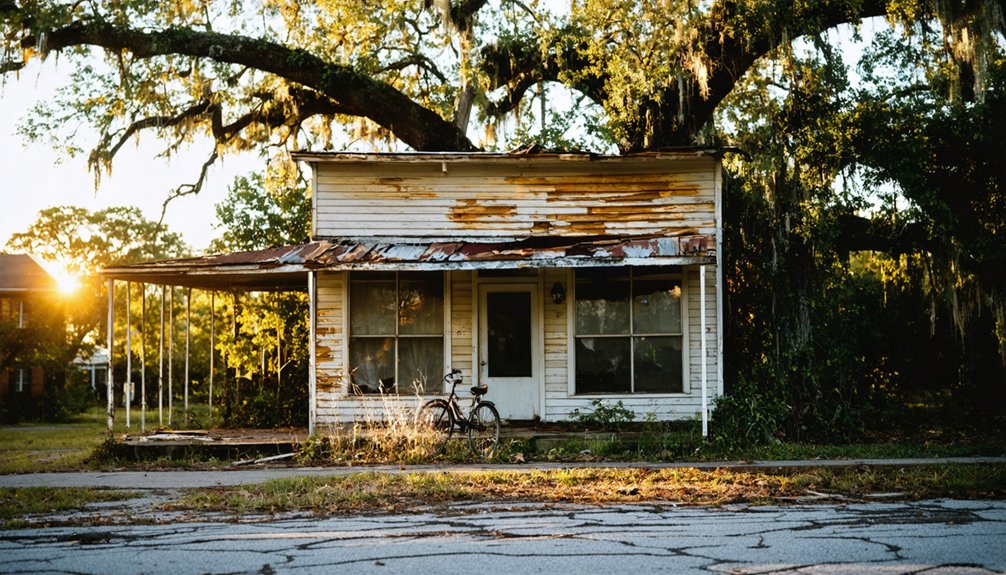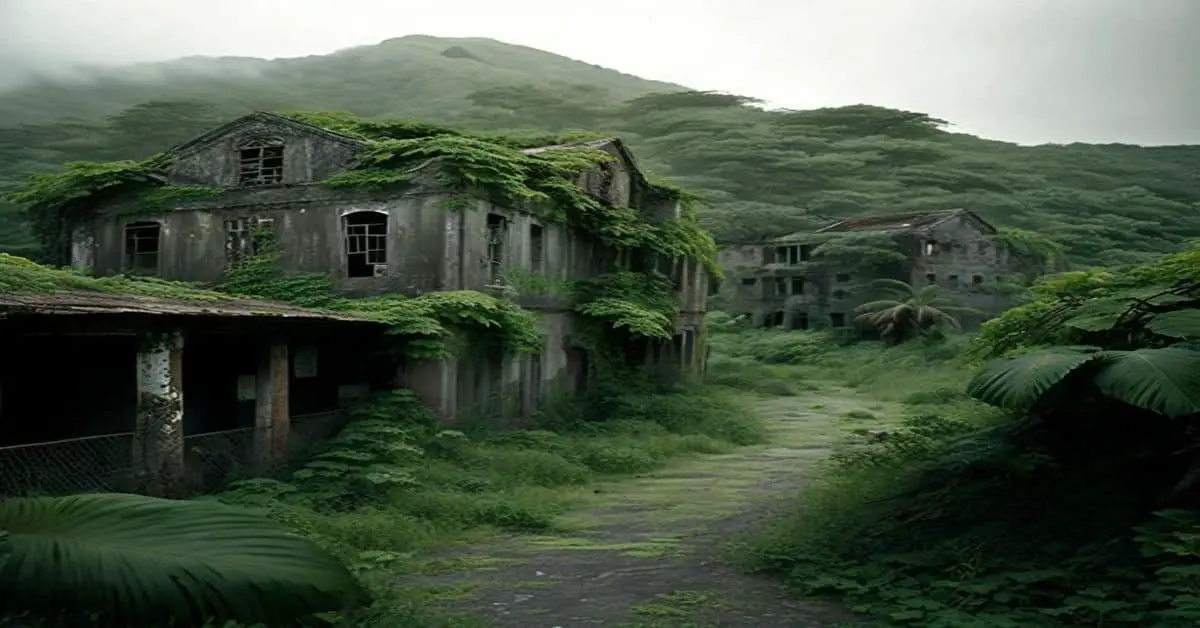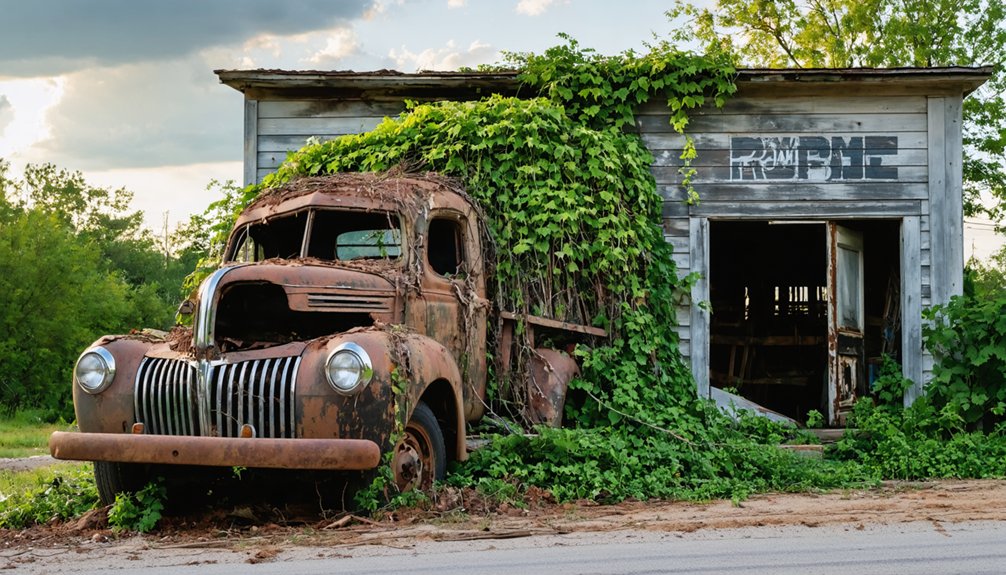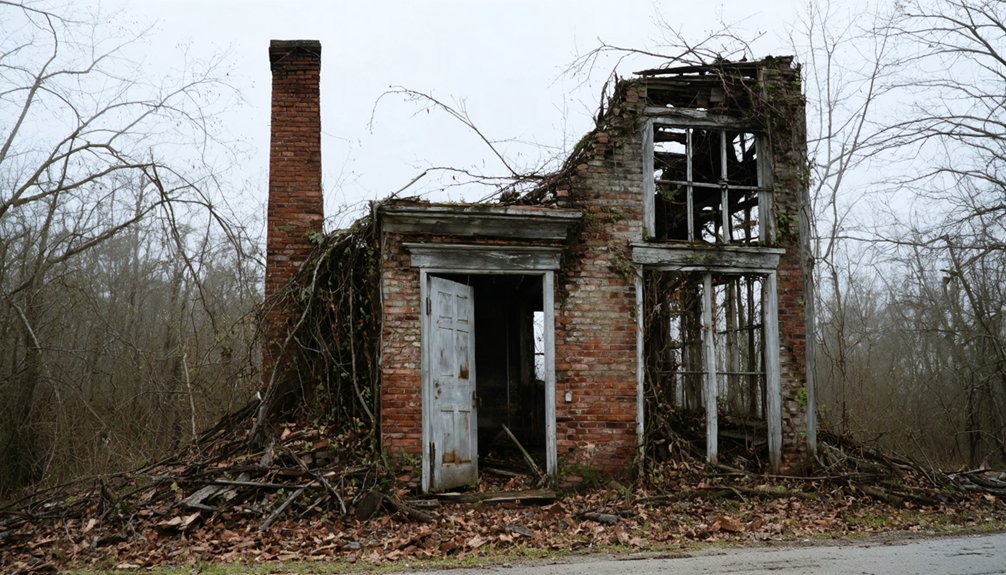You’ll find Bluff City‘s ghost town ruins in Morgan County, Alabama, where it was first established as Monroe in 1818. The settlement, renamed Bluff City in 1857, thrived through early pioneer migration and French Bonapartist refugee settlements. Disease outbreaks, shifting transportation routes, and economic challenges led to its abandonment. The site now lies scattered across overgrown landscape atop the Prairie Bluff Chalk Formation, holding untold stories of frontier life.
Key Takeaways
- Bluff City, Alabama was established in 1818 as Monroe and served as a significant trading post along transportation routes.
- The town experienced multiple yellow fever epidemics, contributing to population decline and eventual abandonment.
- Located near the Alabama River, Bluff City relied on steamboat trade and cotton transportation for economic growth.
- The Prairie Bluff Chalk Formation caused environmental instability, affecting the town’s long-term sustainability.
- Today, the ghost town contains limited physical remains across an overgrown landscape with minimal visitor facilities.
Origins and Early Settlement (1818)
While Alabama was still a territory, Bluff City emerged as a settlement originally named Monroe in 1818. You’ll find its roots deeply connected to the Treaty of Turkeytown, which opened up vast tracts of Cherokee land for settler migration into what would become Morgan County.
The town’s establishment coincided with a wave of pioneers moving west from Tennessee, Georgia, Virginia, and the Carolinas. The treaty implications transformed the region’s landscape, as settlers quickly established themselves around waterways and fertile lands. Like Old St. Stephens, the settlement suffered population decline after epidemics struck the region. During this time, French Bonapartist refugees were settling nearby areas, having fled to America following Napoleon’s defeat.
Monroe’s strategic location in Morgan County made it an attractive destination for early settlers, and you’ll notice the town’s importance reflected in its post office establishment, which served the growing community until 1857 before the settlement later became known as Bluff City.
Life in Early Monroe County
Early life in Monroe County reflected a complex tapestry of cultural and economic interactions between English and Scots-Irish settlers, Muscogee (Creek) peoples, and an expanding enslaved African American population.
You’d find most settlement patterns concentrated along the Federal Road, where communities formed around crossroads like Burnt Corn. Cultural interactions were particularly evident there, with intermarriage between Native Americans and white settlers being common. Travelers required passes from Creeks to journey through the territory in the early 1800s.
Life centered around subsistence farming and cotton cultivation, while taverns and trading posts served as essential community hubs. Following the Treaty of Fort Jackson, most Creek lands were forcibly ceded to the United States, forever altering the region’s demographics and land ownership patterns.
You’d have relied on militia and makeshift forts for protection, as law enforcement was sparse. The region’s infrastructure remained basic, with unpaved roads and few bridges, while river transport via the Alabama River provided the main link to the outside world.
Historical Significance and Location
Located in Morgan County, Alabama, Bluff City emerged as a notable settlement in 1818 under its original name Monroe.
After 1857, the town underwent a significant alteration when it changed its name to Bluff City, with the post office officially reopening under this new name in 1874. Similar to how Old Cahawba thrived before becoming abandoned, Bluff City experienced its own period of growth and change.
The historical context of this period reflects the broader changes sweeping through Alabama during the 19th century, as communities adapted to evolving economic and social conditions. Yellow fever epidemics contributed significantly to population decline in many Alabama towns.
Geographical factors played an essential role in the town’s development, as its location within Morgan County positioned it within the region’s transportation networks and natural features.
You’ll find that this settlement’s shift from Monroe to Bluff City marks a pivotal chapter in Morgan County’s development during America’s post-Civil War era.
Daily Life and Community Structure
In Bluff City’s heyday, you’d find townsfolk gathering regularly at church socials, agricultural fairs, and community meetings that served as the backbone of rural social life.
The town’s leadership structure typically centered around prominent merchants and landowners who coordinated with religious leaders to maintain social order and facilitate local governance. Salem Baptist Church and Arrington Chapel were central gathering places that brought the community together for worship and fellowship.
Local trade networks connected Bluff City’s residents to neighboring communities through a system of merchants who established regular routes for goods and services, while farmers brought their crops to market and traded with traveling salesmen. Similar to Capps, the town served as an important shipping point for agricultural goods from surrounding farms.
Rural Social Gatherings
Rural social life in Bluff City revolved around multifunctional venues that served as essential community hubs. You’d find locals gathering at the historic 137-year-old Bluff City Inn, where social gatherings shaped the town’s vibrant community spirit.
The general stores and blacksmith shops weren’t just places of commerce – they transformed into informal meeting spots where you could exchange news and share stories with neighbors. The town’s old service station became another popular spot for residents to socialize. Like many communities that would become ghost towns, Bluff City’s population gradually declined as people moved away.
Churches played a central role in community bonding, hosting everything from Sunday services to potlucks and picnics. You’d experience a rich tapestry of seasonal celebrations and holiday events in outdoor spaces near main streets.
The spirit of mutual support was evident in home gatherings, where neighbors would help each other with farming tasks and share resources, strengthening the social fabric of this close-knit rural community.
Community Leadership Structure
While maintaining order in frontier settlements posed unique challenges, Bluff City developed a well-structured leadership system that combined formal and informal authority figures.
You’d find elected officials, like the town magistrate, working alongside prominent merchants and landowners in shaping community governance. Local marshals handled law enforcement, while justices of the peace settled minor disputes.
The leadership dynamics extended beyond civil authority, with church leaders wielding significant influence over both moral and civic matters.
The town’s religious gatherings often served dual purposes as forums for community decision-making. You’d see postmasters, shopkeepers, and school principals contributing to administrative oversight, while town councils coordinated essential infrastructure maintenance, from road repairs to water supply management.
Local Trade Networks
Living in Bluff City meant participating in a complex web of local trade networks that operated largely through barter and personal relationships.
You’d find most exchanges happening through informal barter systems, where you might trade your farm’s cotton for a blacksmith’s repairs or exchange preserved foods for essential supplies at the general store. Cash was scarce, so you’d rely on these trade relationships to get by.
The church and school served as primary hubs for arranging trades and sharing market information.
If you lived near the river, you’d occasionally access goods from flatboats or steamboats, but most commerce stayed local.
You’d participate in seasonal markets for livestock sales and larger exchanges, while women’s networks facilitated trades of home-produced goods like textiles and preserved foods.
Economic Activities and Trade
You’ll find that Bluffton’s strategic location helped establish crucial agricultural trade routes connecting local farmers to broader markets through both rail and road networks.
Local merchants maintained busy general stores and markets where residents could purchase essential supplies and trade their harvested goods, creating a self-sustaining economic ecosystem.
The town’s position along these trade routes attracted traveling merchants who brought specialized goods and services, enriching the local economy beyond its mining-based foundation.
Agricultural Trade Routes
Agricultural trade routes in early Alabama centered on three primary transportation methods: rivers, roads, and railroads. You’d find steamboats steering the Alabama River by 1820, carrying cotton bales from Black Belt plantations to the bustling port of Mobile.
From there, your cotton would make its way to markets in New England and Europe.
If you were moving livestock, you’d likely use the stagecoach routes and rough roads connecting towns like Eufaula and Montgomery. The piney woods of South Alabama saw significant livestock trade, with cattle being driven to local markets and some beef shipped from Mobile.
Later, when railroads arrived, they’d revolutionize cotton transportation and livestock trade, connecting major agricultural centers and making it easier to reach distant markets without relying solely on river transport.
Local Merchants and Markets
Commerce in Bluff City revolved around a tight-knit network of merchants who often wore multiple hats in the community. You’d find cotton farmers doubling as traders, like William A. Smith, who balanced agricultural work with running local businesses.
These merchant interactions created a sustainable economic ecosystem where everyday necessities, food staples, and even distilled beverages were readily available.
Trade practices were significantly informal and community-driven, with unique distribution methods like the “Bell Tree” system for moonshine sales. You’ll find that merchants adapted to the rural economy by accepting both barter and cash payments.
Their success was closely tied to the town’s liveliness, and when transportation routes shifted or epidemics struck, many establishments struggled. The closure of essential facilities like post offices often marked the beginning of the end for local market activity.
The Path to Abandonment
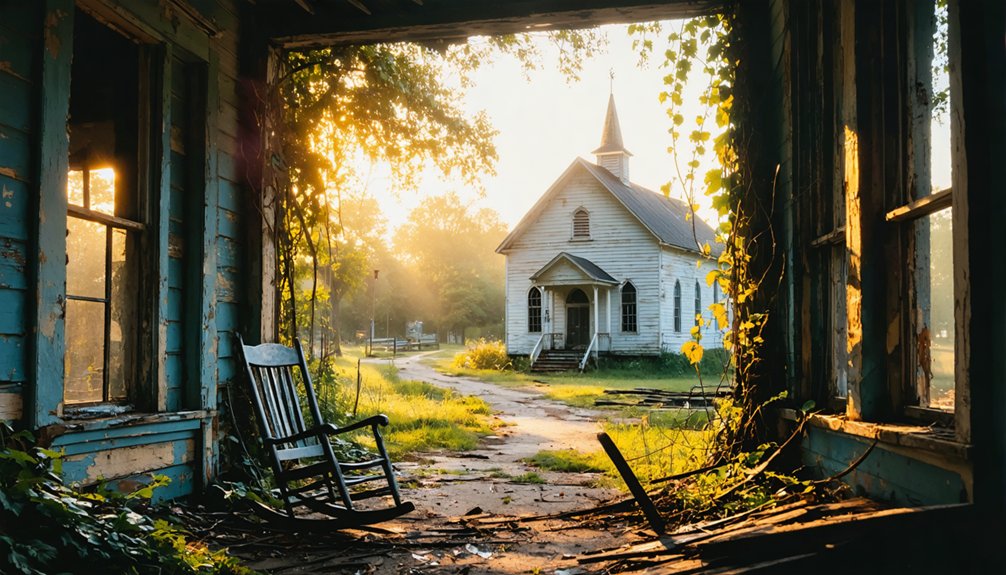
While many ghost towns fade slowly into obscurity, Bluff City’s path to abandonment resulted from a perfect storm of economic, social, and environmental challenges.
You’ll recognize the community decline through these major catalysts that sealed the town’s fate:
- Economic challenges hit hard as traditional industries faltered and competition from larger industrial centers drew away business.
- Transportation shifts bypassed the town entirely, cutting off essential trade routes that once sustained local commerce.
- Environmental factors, particularly the town’s location on the Prairie Bluff Chalk Formation, created ongoing stability issues.
You’ll find that these pressures intensified when administrative changes stripped away the town’s political significance.
As health epidemics swept through, surviving residents sought opportunities elsewhere, leaving behind empty buildings and abandoned dreams.
Notable Landmarks and Features
Despite the passage of time, several notable landmarks stand as silent witnesses to Bluff City’s former existence. You’ll find remnants typical of Alabama ghost towns, including weathered cemetery plots where early settlers rest, and foundation stones that once supported homes and community buildings.
While ghostly encounters have been reported by curious visitors, the real treasures lie in the historical artifacts that occasionally surface after heavy rains.
Beyond reported paranormal activity, Bluff City’s true allure lies in the historical treasures unearthed by rainfall’s gentle touch.
The town’s layout follows patterns similar to other abandoned Alabama settlements, with traces of old roadbeds leading to what was likely the town center.
If you explore carefully, you might discover pieces of daily life from the past: fragments of pottery, metal tools, and other remnants that tell the story of those who once called this place home.
Legacy in Alabama’s History
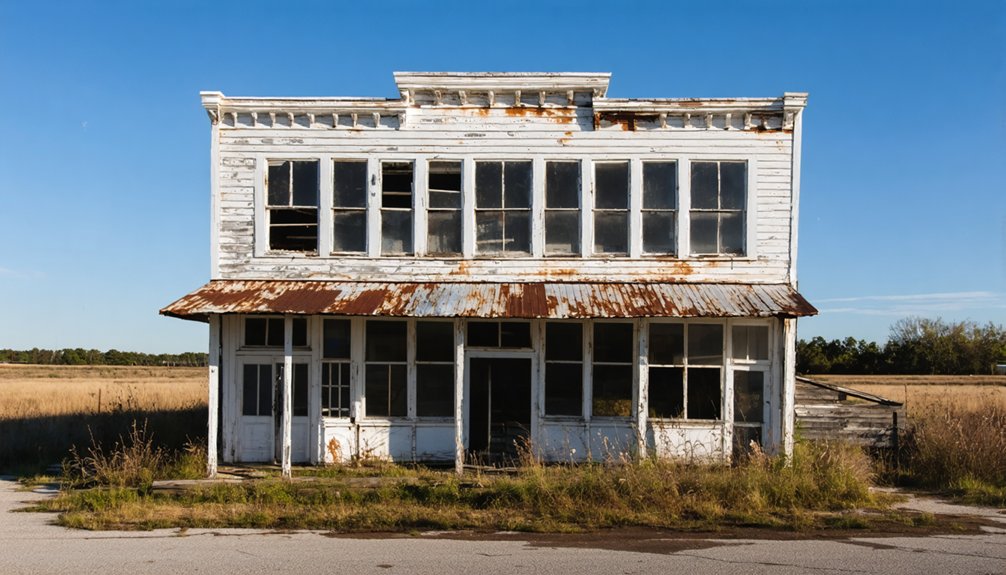
As a significant marker in Alabama’s territorial development, Bluff City represents broader patterns of settlement, economic shifts, and societal changes that shaped the state’s history.
Like many ghost town narratives across Alabama, Bluff City’s story mirrors the state’s evolution from Native American territories through early statehood and beyond. Historical preservation efforts help you understand the complex factors that influenced the town’s rise and eventual abandonment.
- The town’s decline reflects Alabama’s changing economic landscape, particularly during shifts in mining, agriculture, and transportation routes.
- Archaeological remains provide valuable insights into early settler life, community organization, and infrastructure development.
- Bluff City’s legacy contributes to understanding how health crises, political changes, and economic competition influenced rural Alabama’s development.
Present-Day Site Conditions
Today, Bluff City stands as a shadow of its former self, with limited physical remains scattered across an increasingly overgrown landscape. You’ll find only ruins, foundations, and fallen timbers beneath encroaching vegetation, with no intact structures remaining on the premises.
Site accessibility presents significant challenges, as you’ll need to navigate unpaved roads and trails with minimal signage to reach the location.
When exploring, you’ll want to reflect on visitor safety, as the remote area lacks emergency services and features uneven terrain, wildlife, and seasonal flooding risks. There’s also a notable absence of basic facilities or interpretive markers to guide your visit.
The surrounding woodland and natural elements continue to reclaim the site, while local preservation efforts focus mainly on protecting remaining artifacts from vandalism.
Frequently Asked Questions
Were There Any Documented Native American Settlements Near Bluff City Before 1818?
You’ll find historical evidence shows Creek Confederacy settlements existed near the area, while archaeological findings confirm Native settlements in nearby Morgan County and surrounding river valleys before 1818.
What Type of Housing Structures Were Most Common in Bluff City?
You’d likely find log cabins were the predominant housing type, based on typical Alabama ghost town patterns, though there’s no direct evidence of Victorian architecture or other specific building styles in Bluff City.
Did Any Prominent Alabama Historical Figures Live in Bluff City?
You won’t find documented evidence of prominent Alabama historical figures residing in Bluff City, though William A. Smith, a local cotton farmer and businessman, wielded significant influence in the surrounding area.
What Natural Disasters or Epidemics Affected Bluff City During Its Existence?
While exact records are scarce, you’ll find that nearby Claiborne lost 75% of its population to yellow fever and cholera by 1872, suggesting similar disease outbreaks likely impacted Bluff City’s mining community.
How Did Mail and Communication Services Operate in Bluff City?
You’d find postal routes running through Bluff City’s official post office from 1881-1887, with communication methods including mail delivery by rail and river transport, plus likely telegraph services nearby.
References
- https://deepsouthurbex.com/2020/01/02/6-south-alabama-ghost-towns/
- https://digitalalabama.com/article/alabama-ghost-towns/page/3
- https://digitalalabama.com/alabama-ghost-towns/alabama-ghost-towns/9449
- https://en.wikipedia.org/wiki/Prairie_Bluff
- http://samhardin.family/bluf1.htm
- https://en.wikipedia.org/wiki/List_of_ghost_towns_in_Alabama
- https://penelope.uchicago.edu/Thayer/E/Gazetteer/Places/America/United_States/Alabama/_Texts/French_Military_Adventurers_in_Alabama*.html
- https://www.alabamapioneers.com/some-early-towns-in-alabama/
- https://www.alabamahistory.net/marengo
- https://alabamanewscenter.com/2018/06/14/day-alabama-history-cotaco-became-morgan-county/
